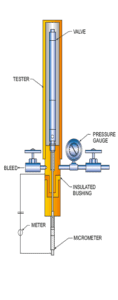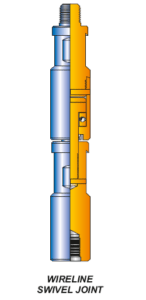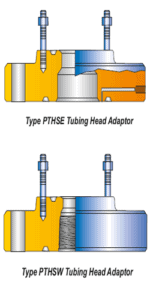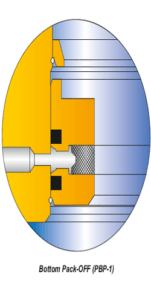Model “BP” wire line pressure setting tools are compact tools inside which the ignition and burning of a pyrotechnic power charger (manufactured by TITAN SPECIALTIES, Pampa, Texas) produces gas pressure that elongates the tool. This provides the stroke and force necessary to set and anchor conventional bridge plugs, packers, and cement retainers provided by various manufacturers. The tools feature pressure balanced top and bottom pistons to eliminate pre-setting of the mentioned products caused by high hydrostatic well pressure.
Operation:
An electrically actuated high temperature rated igniter (also manufactured by TITAN SPECIALTIES) located at the upper end of the tool is ignited and produces a flash flame which, in turn, ignites the power charger that is located directly below the igniter. The power charger, which is constructed of carefully controlled combustible elements, begins a slow burn lasting approximately 30 seconds. The resultant gas derived from the burning charge gradually builds to high pressure and causes the tool to elongate.The pressurized gas migrates down the center of the top piston and out into an annular cavity formed between the top piston and connector sub. The pressure acting on this area drives the outside of the tool (consisting of top and bottom cylinders) downward while the top and bottom pistons remain stationary. This motion anchors the bridge plug to the casing ID then pulls the shear stud of the bridge plug apart, freeing the setting tool for removal from the well.An oil damper system is built into the tool to control the speed at which the tool strokes. As the tool elongates, this oil is forced through an annular orifice and out of the tool at a controlled rate and prevents the tool from stroking too fast, causing damage to the tool once the shear stud has parted.
Note: It is mandatory that the tool be filled to capacity with oil.
Excess oil will be purged out automatically during assembly. Likewise, oil expansion caused by high well temperature during running will be purged in the same manner. In wells where hydrostatic pressure is less than 10,000 psi, all tool sizes are available with manual bleeder valve assemblies. This valve provides a safe, easy method of bleeding trapped gas pressure from the tool before disassembly is begun. When bottom hole pressures exceeding 10,000 psi are to be encountered, the manual bleeder valve and its corresponding sub are replaced by a portless sub. Bleeding is then accomplished by backing the firing head out of the setting tool. Both methods of bleeding pressure are illustrated in the disassembly steps found later in this manual.





